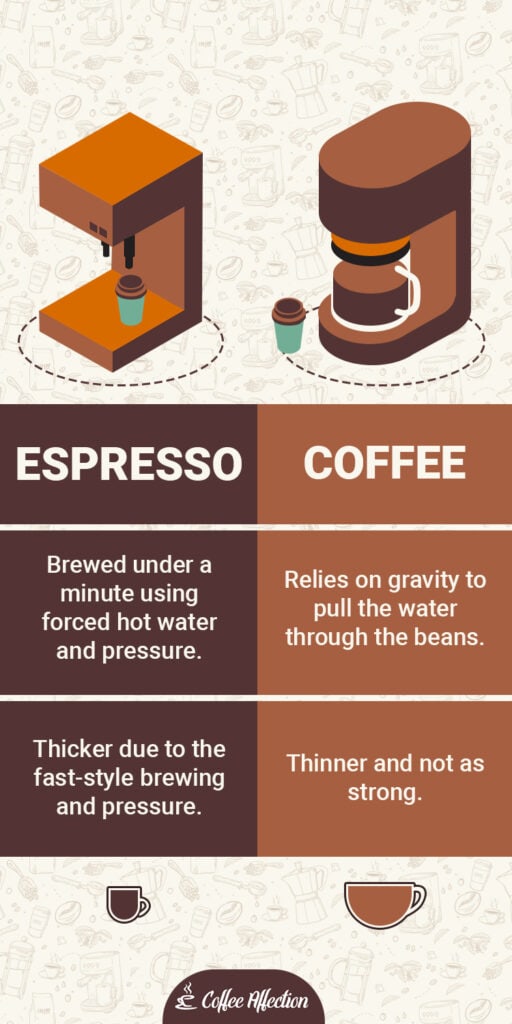
The history of coffee is a long and complex tale, often a mixture of facts and legends. There are many different twists and turns in the history of coffee in general and specific types of coffee and brewing methods. Espresso is an excellent example of a type of coffee product with a fascinating history. It’s a cultural aspect in quite a few countries, especially the country in which it originates. Espresso is genuinely unique and plays a significant role in coffee shops and drink recipes, so it is good to know the history behind it. Who invented espresso, and when was it invented? Let’s find out!
All About Espresso

Before getting into the history of espresso, it’s important to understand what it is and why it is different than other types of coffee. Let’s look at what espresso is and how it differs from regular coffee:
What is Espresso?
Espresso is a small concentration of coffee that uses pressurized hot water through packed-down coffee beans. The extraction method of brewing espresso creates a slightly thicker liquid than drip-brew coffee and brews much faster. Espresso usually has crema on top, a layer of foam-like bubbles that form from brewing espresso. While any coffee bean can go through the espresso extraction process, most espresso is a dark roast blend of Arabica beans or a mix of Arabica and Robusta beans.
Espresso vs. Coffee
Espresso and coffee share many similarities, but they also have clear differences that separate them. While espresso is brewed under a minute using forced hot water and pressure, regular coffee goes through a coffee maker and relies on gravity to pull the water through the beans. Espresso is also thicker due to the fast-style brewing and pressure, whereas coffee is thinner and not as strong.

The History of Espresso
Who Invented Espresso?
So when was espresso invented, and by who? Italy is considered the birthplace of espresso, dating back to around 1884. Espresso was invented by a man named Angelo Moriondo, who create the world’s first official espresso machine. It was the first coffee machine of its kind to have separate control over the water and steam. Moriondo successfully patented his machine and adjusted it over the years, but he never fully commercialized his invention. Regardless, his patent and “instantaneous” coffee maker was the first of its kind.
Espresso Through the Centuries
Although today’s espresso machines are quite different from the original, the concept of espresso hasn’t changed as much. After Moriondo created the first espresso machine, other inventors sought out to create their own version with the same concept in mind. It wasn’t until 1903 that the espresso machine was produced at a much bigger scale, creating the opportunity for espresso to grow. Espresso became popular in Italy as coffee bars started forming, creating a distinct culture around the beverage.
Throughout the years, espresso took on different forms and recipes. The cappuccino was invented after the creation of the espresso machine, sometime between the 1900s and 1930s. During World War II, the Americano (espresso diluted with hot water) was allegedly invented for US soldiers because the espresso was too strong compared to the American-style coffee they were used to. By the 1950s and 60s, espresso reached the shores of the United States and started becoming an important staple in coffee shops. The latte was also invented in the United States during this time, though it didn’t reach its popular status until Starbucks featured it in the late 1980s and 90s.
Today, espresso remains to be one of the most important aspects of coffee culture. It’s a worldwide phenomenon and an irreplaceable ingredient in many coffee drinks. While there are many new coffee trends that hit the coffee scene, espresso shows no sign of slowing down. At-home espresso makers are becoming more affordable, making it possible to make any kind of espresso drink at home.
Conclusion
Espresso is a coffee drink that many people love and appreciate, a cultural staple in Europe and other regions. Originating in Italy, it is still a huge part of the Italian culture and lifestyle. It has an interesting history that created a whole new method to brewing coffee, changing the way we look at coffee in general. If it wasn’t for the invention of espresso and the espresso machine, the fancy coffee shop drinks we drink and enjoy daily wouldn’t exist today.
Featured Image Credit: Tyler Nix, Unsplash















